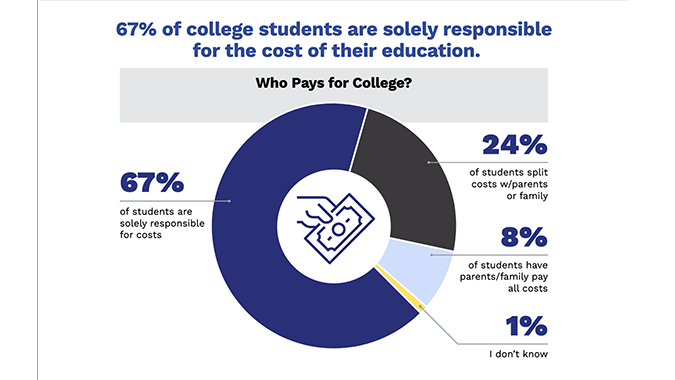As college students prepare to head back to campus for another academic year, nearly two-thirds (65%) will be stuggling to shoulder education expenses completely on their own.
A recent survey of 1,200 students from edtech provider Cengage found that while students are grappling with affordability, the majority still feel strongly that their education is worth the cost. Not surprisingly, students identified tuition as their biggest pain point, and almost 81% said colleges should spend more money on learning materials and less on student amenities.
“Affordability continues to be a major barrier for today’s college students,” said Kevin Carlsten, senior vice president of the U.S. Higher Education Institutional Group at Cengage. “But despite struggling to keep up with tuition and other costs, students still believe in the power of a college education. In order for that faith in education to continue, more needs to be done collectively to lower cost barriers.”
Additional survey findings include:
- Most of today’s college students are solely paying for their education, with a higher percentage of two-year students paying their own way. Sixty-one percent of four-year students are solely paying their education costs, and 29% are splitting costs with parents or family. Meanwhile, 71% of two-year students are paying all costs while only 19% are splitting costs with their family.
- Students are struggling with education costs. Sixty-eight percent of students say it is a struggle for them or their family members to pay for their education. Students say the biggest pain point is tuition (46%), followed by technology/laptops (21%) and books/course materials (17%).
- Students have little financial buffer – nearly half (46%) have $250 or less left after paying for education costs each month. Fourteen percent of students have only $100 or less left each month after paying expenses.
- Students want lower tuition and would trade amenities for better learning support. Thirty-six percent say the most impactful thing their college or university can do to lower the cost of education is lower tuition, followed by providing more affordable options for course materials (21%). Eighty-one percent said schools should spend more money on providing course materials and less on amenities like dorms, facilities, and athletics.
- Most students (78%) think their education is worth what they’re paying – as long as college is a gateway to financial independence. Students say earning a salary that allows financial independence (48%) followed by getting a job quickly (27%) and paying off their debt in 10 years (11%) are the most important drivers of worth.
Cengage’s college affordability survey polled 1,200 Americans ages 18-44 who are enrolled in a two-year or four-year college or institution for an undergraduate degree. Respondents were also filtered by income level with 600 responses coming from students with Household Income (HHI) under $75,000 and 600 respondents from students with HHI over $75,000.

